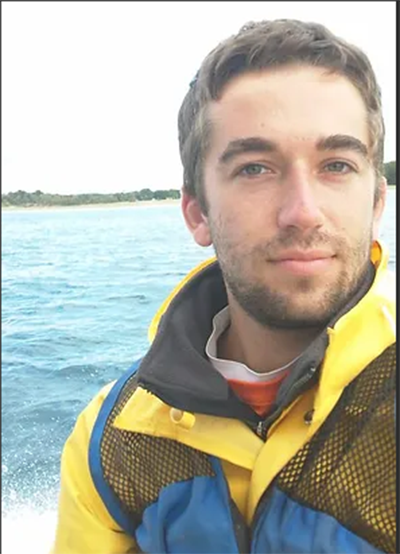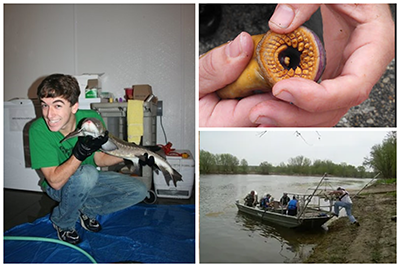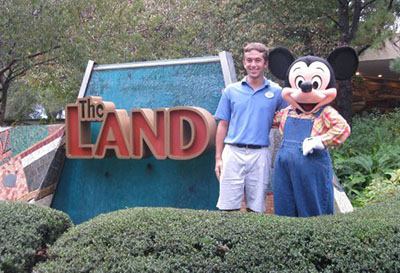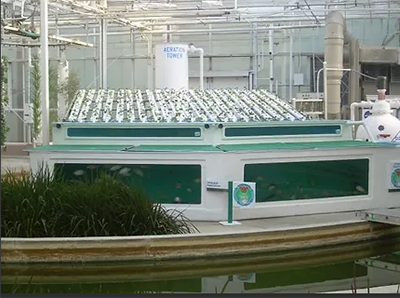Growing up in Huntertown, Indiana, just north of Fort Wayne, Austin Happel could often be found playing in and around the woods and a small pond near his house, trying to figure out what fish lived there or watching turtles and frogs.
and around the woods and a small pond near his house, trying to figure out what fish lived there or watching turtles and frogs.
“I remember having a large net that people would normally use to clean out a pool and jabbing that in the water to see what I could find, or taking a canoe around to see the different fish nests or the beds that they were making, or see what turtles were where. I remember it froze over one year. It was crystal clear and you could see very large snapping turtles overwintering. You could see them through the ice, and also some frogs, which I thought was super cool. Each winter I would hope that it would freeze again, so we could go out and see them.”
During his high school years, Happel took a job managing the fish section of a local pet store and he planned to continue on that path in college.
“I was really interested in helping people understand what fish can live together, how to keep them alive, and how to set up their systems so that they would be successful, and I was also taking a lot of chemistry and biology classes in high school,” Happel recalled. “I went to Purdue as an undecided major to explore some things, initially I thought that I would go and get a business degree and continue on the pet store trajectory. As an undecided major, you have to go and talk to a bunch of different programs to learn about your major options, so I talked to some people in the Forestry and Natural Resources department about the aquatic sciences degree. I realized that you could take classes that got you outside and that were essentially what my high school hobbies were. Eventually I met up with Trent Sutton and he had a couple of grad students that were doing some work out at the Aquatics Research Lab (ARL) that needed someone to help them keep the fish fed, and the tanks or containers clean. To me that felt very much like working in the pet store’s fish section. Combining those two things led me to switch into the degree program.”
my high school hobbies were. Eventually I met up with Trent Sutton and he had a couple of grad students that were doing some work out at the Aquatics Research Lab (ARL) that needed someone to help them keep the fish fed, and the tanks or containers clean. To me that felt very much like working in the pet store’s fish section. Combining those two things led me to switch into the degree program.”
At the Aquaculture Research Lab, Happel worked with brook trout, salmonid eggs and alevins, feeding them, removing fungus and siphoning out waste. He also worked on a project with Sutton and Dr. Marisol Sepulveda, which sought to see what the effects of sea lamprey attacks were on large lake sturgeon. A project with Dr. Reuben Goforth in the Wabash River and local streams, had Happel participating in electrofishing and analyzing stomach contents of shovelnose sturgeon.
“I thought all that was super cool to be helping out with, watching or being involved in,” Happel said. “I also was involved with the student chapter of AFS (American Fisheries Society), helping keep that going and bringing in a lot of workshops to expand our experience with different techniques. We brought in people that could teach us how to fly fish or how to dissect a fish and diagnose diseases, or to show us how the different settings affected what we were doing when we were out electrofishing. I was really interested in how we could leverage the student chapter to learn more outside of the classroom.”
While in FNR, Happel attended the College of Agriculture Career Fair, where he met a representative from the Disney College Program.
the Disney College Program.
“There's always a Disney College Program booth, but the person that was manning the booth that year was specifically there because he got his degree from Purdue, and he was trying to recruit people for his internship program, which operates out of Epcot and the Land Pavilion,” Happel explained. “Within the Land Pavilion they showcase agriculture techniques, including aquaculture. I talked to him for a bit, but I was too early in college to be able to apply for that program as you have to be pretty close to graduating or have just graduated to get into it. So, I waited and eventually got old enough where I could apply and interview for it and got it.
“The internship was raising fish within their aqua cells. They raise nine different fish species that eventually go for food in the restaurants somewhere within the park system there. The aqua cell is attached to a bunch of greenhouses where they grow plants without soil, using different mediums to grow the plants. We also were dabbling in aquaponics, which is using fish waste to grow the plants. Part of my job was giving tours of the greenhouses, the integrated pest management lab and the aquaculture center, so I got a lot of experience, learning about how to grow plants and those greenhouses as well as what we were doing with the fish. It was a cool program.”
Happel’s work at Disney included a project that tried to identify which food items Macrobrachium shrimp preferred and which caused them to molt more quickly. He also investigated methods of adding structure to their tanks to reduce competition/cannibalism.
After completing his bachelor’s degree at Purdue in 2010, Happel headed down the road to Champaign, Illinois, where he spent the next seven years researching Great Lakes food webs.
“I was really interested in figuring out who ate what,” Happel said. “Now I look back and think ‘Oh, man, even at the pet store I was trying to feed fish different things so that they were healthier or more vibrantly colored, or so they would stop fighting each other.’ The University of Illinois had a food web study that was working with Tomas (Höök) as a co-PI on the project. Working with the Lake Michigan Biological Station, we tried to decipher food webs, how diets affect fish and how diets change based on environmental factors.”
While in Champaign, Happel looked at the spatial components of young of year yellow perch diets in Lake Michigan, discovering that perch on the eastern side consumer more pelagic items, whereas those on the western side consumed benthic invertebrates. He investigated similar questions in the spottail shiner population, finding that the fish consumed different items based on where they were caught. He also studied lake trout in Lake Michigan and Lake Huron and found their diet compositions differed, likely explaining that diet diversity gave those in Lake Huron a relief from thiamine deficiency. Happel explored a technique which used fatty acids to decipher what fish ate through several feeding experiments. These projects offered a means of understanding the Great Lakes food webs and was put to use across several food web studies. For example, Happel explored the food web of piscivorous, or fish eating, fish in Lake Ontario leveraging his fatty acid expertise.
Lake Michigan, discovering that perch on the eastern side consumer more pelagic items, whereas those on the western side consumed benthic invertebrates. He investigated similar questions in the spottail shiner population, finding that the fish consumed different items based on where they were caught. He also studied lake trout in Lake Michigan and Lake Huron and found their diet compositions differed, likely explaining that diet diversity gave those in Lake Huron a relief from thiamine deficiency. Happel explored a technique which used fatty acids to decipher what fish ate through several feeding experiments. These projects offered a means of understanding the Great Lakes food webs and was put to use across several food web studies. For example, Happel explored the food web of piscivorous, or fish eating, fish in Lake Ontario leveraging his fatty acid expertise.
Throughout his work at Illinois, Happel called back to knowledge he gained as an undergraduate at Purdue.
“I remember working with Reuben to go through, identify and count zooplankton from some Great Lakes locations, as well as some rivers and ponds,” Happel recalled. “We also collected a lot of macroinvertebrates from some of the streams and from the Wabash River. And then, when he was collecting stomachs of sturgeon from the Wabash River, I helped go through them. All of that identification of various things that ended up in the stomachs of the fish helped as I did my master’s research. We were counting and identifying various fish and a bunch of different invertebrates or zooplankton from stomachs of fish, and I already had the knowledge of what those looked like and how to identify them, etc.”
In addition to his research at Illinois, Happel had the opportunity to teach various courses, workshops and labs, which set him up perfectly for a postdoctoral position at Colorado State University.
“I had done some teaching and also was able to develop and teach a course, so I knew that I was somewhat interested in the academic route,” Happel said. “I was looking for jobs that included some form of teaching, and the Colorado State position was posted, which was a teaching focused postdoc. I came to fill in and teach for a professor who was going on sabbatical. While most of my time over those 18 months was spent teaching courses, I also tried to leverage my time to pick up research projects or help others publish their projects if I could. I got linked up with someone who had data from an aquaculture project that they needed written up and I ended up getting a paper out of the experience as well.”
spent teaching courses, I also tried to leverage my time to pick up research projects or help others publish their projects if I could. I got linked up with someone who had data from an aquaculture project that they needed written up and I ended up getting a paper out of the experience as well.”
Happel taught courses ranging from Introduction to Fish Biology to Principles of Wildlife Management to Biodiversity of Fishes, Field Wildlife Studies and a math-oriented Fisheries Science capstone course.
“Fish biodiversity was probably my favorite course, because I just got up and tried to get people excited about various aspects of fish, whether that was the diversity of fish that are out there or the differences between fresh and salt water fish or how they see color, or what different colors of fish flesh mean?” Happel shared. “I thought that was a super fun course and several students stated it was as well. I also taught an introduction to fish and wildlife management course, basically about how you track populations regardless of what the species is and what management options you have to increase or decrease of population.”
As he considered his next step after the postdoctoral position, Happel looked back towards home and a familiar venue.
“I had been watching Shedd Aquarium over the years as they evolved their research program from a postdoc model to a full-time staff that would carry out conservation work with the goal of creating positive stories that could get people interested in the world around them,” Happel said. “When they finally posted some of the roles for this program, I called the two people I knew that were already at Shedd and got the downlow on what they were looking for, if I was a fit for what they were doing and how best to apply. I submitted my packet, got invited for the interview and got a sense for what they wanted and now I am here.”
As one of eight full-time research biologists at Shedd, each with their own assigned research and outreach theme, Happel works on the theme of urban freshwater ecosystems under a mandate to do conservation research that will be of interest to the public.
“There is a storytelling aspect to getting other people excited about the world around them; it needs to be research that we can easily talk to the public about,” Happel said. “For me, being under the urban freshwater theme and with Shedd being located in Chicago, research surrounding the Chicago River made a lot of sense. There's a lot of data collected about the river, but not a whole lot of storytelling related to it and its surprising how positive those stories can be. At the moment, we are focused on sharing that the water of the Chicago River is way cleaner than one might expect, that cleaner water has brought a tripling in the number of fish species, and about a tenfold increase in the abundance of fish within the river since the 1980s. That speaks highly to how our city is handling and treating the water that runs through it. It is a lot of fun to tell people that there are actually a lot of fish in there. You’d be surprised what you can catch; it is not the sewage pit that a lot of people think it is.”
Around once a month Happel meets with student groups to talk to them about either what it's like to be a![]() biologist, or how Shedd researches fish, or what's happening with the Chicago River. He also meets with teachers to talk to them about some of those things, so they, in turn, incorporate them into their lesson plans and share with their students information about the world around them.
biologist, or how Shedd researches fish, or what's happening with the Chicago River. He also meets with teachers to talk to them about some of those things, so they, in turn, incorporate them into their lesson plans and share with their students information about the world around them.
Happel and his colleagues also meet with the public at outreach events, such as Tap into the Chicago River or the Kayak for Conservation program. The Tap into the Chicago River program takes place at different breweries along the river every other month and keeps residents up to date about what researchers are finding in regards to the ecology of the river system. The Kayak for Conservation program takes members of the public out to visit some of the Chicago River restoration sites, giving many people their first experience on the river.
“We do research that has an impact both on people’s perceptions and on the environment,” Happel said. “We cover the history of the Chicago River, how water quality has changed and how that is now reflected in the biodiversity that we see. The kayak program also takes people over to some floating wetlands that have been installed. They visit those habitats and talk about some of the effects we are seeing and then they help collect data. They count birds and pollinators that they see in the area and eventually I will go through and see how the number of birds has changed since we put the wetlands in. Chicago’s Wild Mile is the largest installation of floating wetlands for the purpose of habitat.”
Happel also works with the city to help guide new developments along the river as a member of the River Ecology and Governance Task Force.
“The Chicago River is prime real estate and we get new developments coming in periodically, so we get to review those development plans,” Happel explained. “There is a group of 50 organizations that get to review development proposals, and Shedd is part of that group. We get to talk to developers about what their land looks like and ways they could promote more biodiversity within the river, and other environmentally friendly things they can do like adding parking space with multi-story plantings to promote bird diversity, using bird friendly glass, putting a wetland in the parking lot so water doesn’t go straight into the river, or generally creating more outdoor space, etc.”
In addition to educating the public on the positives of the Chicago River and the local environment, Happel is part of a collaborative team from Shedd Aquarium, the Höök Lab at Purdue and Illinois-Indiana Sea Grant that is tracking fish in the river to see how shoreline restorations are having an effect under the water.![]()
Luke McGill, who has worked as a stream technician for Trout Unlimited and the U.S. Forest Service, and as a fisheries technician for the Wyoming Game and Fish Department, will be collecting data for the acoustic fish tracking project, alongside Happel’s intern, Emily Rukstales. McGill is a master’s student at Purdue, who is advised by Höök and research associate professor Dr. Paris Collingsworth.
“Shedd was able to get some money from the Natural Resources Conservation Service to help with shoreline and instream restoration projects as well as monitor the efficacy of the projects,” Happel said. “We decided to use some of that money to buy acoustic telemetry, which allows us to put stationary receivers in the water and then equip fish with acoustic tags that emit a sound and a code. If a fish is within the listening radius of these devices, we will know that the fish is there, which then allows us to track where that fish goes throughout the city over time. Do they return to some of these restoration sites and if so, with what frequency? Do they swim past them or hang out by them? Do they only hang out by them during the day or at night and what might that mean?
“Restoration is not immediate and it takes a while to see results. This project is one way we’re trying to see how our fish are using these areas now, offering faster results than looking at population level changes, which can take several years. We can see in real time if fish are visiting these areas frequently as if they’re a food buffet or if they are hiding under them during poor water quality events, etc.”
As Happel continues to spread the word about conservation and research efforts at Shedd Aquarium and beyond, he offers advice to youth and college students who are looking to find their career path, like he once was.
“Sometimes when I'm talking to classrooms, I'll do an exercise where I ask them what they try to do in their free time, that isn’t on their phones,” Happel said. “What are you doing? Here is what that looks like in fields adjacent to me that you might want to consider… For instance, if they say ‘I like talking with my friends about the world around me,’ I say, maybe you want to look into translating science to the lay public or maybe you want to go into media relations. Or if they say, ‘Oh, I love talking to or going out fishing and talking to other fishermen.’ I say, okay, maybe you would be interested in human dimensions and how people interact with the environment around them. Or if they say, I just walk through the park and count birds. I tell them, that's an entire job. These hobbies are jobs, you just have to think creatively about how you can get to them.
“Once you are in college, get involved, talk to your professors, show an interest in what they are doing and see if they have projects or advice for you on what courses to take or who to talk to next. As much as we don’t like to say it, it is a lot about who you know and how they can help you. Not only will they help guide you in your interests and in reaching your goals, but they can also be references and be helpful in your career path.”
Happel has gone from splashing around in a local pond, to a high school job at a pet store and an undergraduate position taking care of fish in a lab to an aquatic science-based researcher at the world-renowned Shedd Aquarium, proof that you can use your hobbies, experiences and connections to set you on a path to the job of your dreams.





